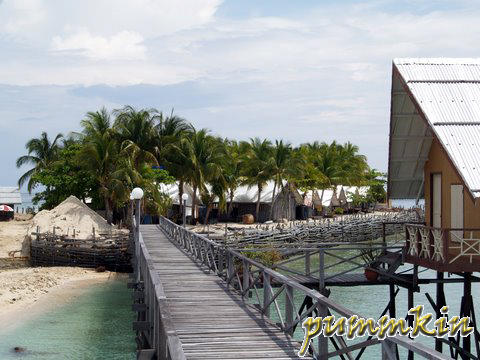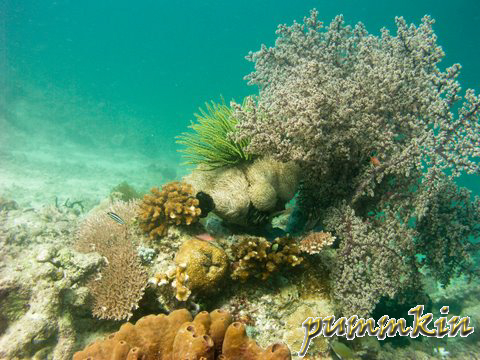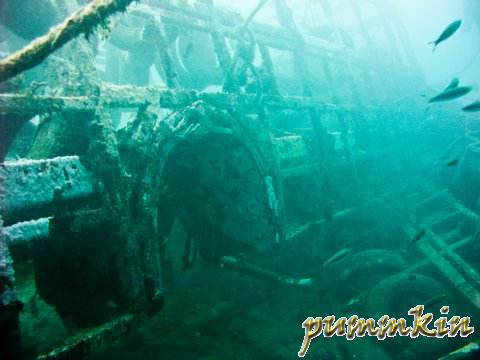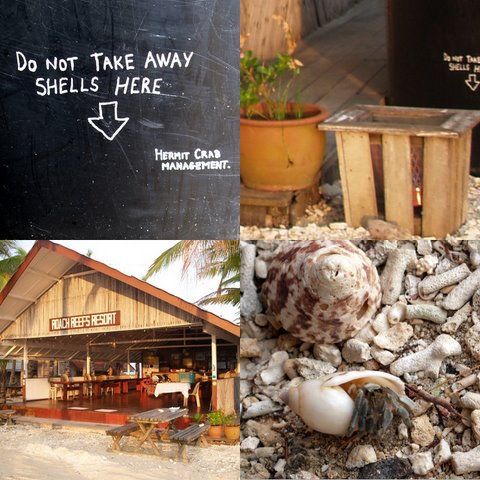On a reef just 30 minutes by speedboat from the town of Tawau, Sabah, lies a little island called Roach Reefs. Surrounded by crystal clear waters, this beautiful man-made isle was constructed when an avid angler decided to build a rest and relax place midway home from the sea. Two barges were sunken to make the base and filled with sand before planting palm trees on the fringe of the island’s border.

The place has now turned into a dive resort, attracting divers from the world over to explore the wonders of Roach Reef. There are 11 individual chalets that accommodate two to a room comfortably. Though Sipadan island can be sighted in the distance, Roach Reefs has got everything that the famous oceanic island has to offer including the wall of swirling barracudas but minus the abyssal depths. Arriving from a hectic schedule of dive training, I was greeted by the white plumage of soaring frigate birds across the puristically blue sky. After hearing tales about the mile long stretch of table corals that carpeted the seabed and the site which enables you to board a mini bus at the bus stop underwater, I was moved to see it for myself.

Once you get down below, schools of Harlequin Sweetlips with tantalising pouts will start converging to their cleaning station for a rub and a scrub. Multi-facetted breams would be greeting you on the top of the reef, staring at you as you whizz pass with the mild current. The maximum depth here does not exceed 24 metres. Superb coral life and the presence of a school of huge bumphead parrotfish makes the scene very much like that of the oceanic Sipadan.
This unique man-made island is on a reef located on the edge of the Borneo continental shelf and is only 50 minutes away from Sipadan. The reef chalets are built in traditional architecture offering charmingly simple accommodation with spacious bathrooms. The friendly and helpful staff rendered their best effort to make my stay truly enjoyable. Each spacious chalet has individual air-conditioning units (although it wasn’t working at the time I was there because the resort was repairing the damage caused by a storm), sea view balcony, private bathroom and toiletries with hot shower and a restaurant serving Asian and Continental cuisine. International phone call service is offered at the office of the reception but not that I need to call anybody when I’m on such an exotic island and the dive centre caters for all in-water activities including scuba training and education.
Divemasters here are very knowledgeable of the local dive sites & residents beneath the waves to lead you to the exact spot where the orang utan crab lives! The laid back lifestyle on this island will turn any holiday maker into one big, lazy orang utan (as I felt like one) and with the Divemaster determining who is more exciting to watch underwater would be a challenge at the end of the fourth day. The boat crew work hand in hand to ensure you have a stress free holiday and maximum sightings of unusual marine life!!!
I would sleep after every dive, simply because the island is so breezy and with the swaying palm leaves, the passage between the chalets on the island is shielded from the sun. Diving can be a little energy sapping when you fight against the current taking pictures of the shy and elusive crabs underwater. Couple that with some ambitious planning of making 4 – 5 dives a day, would leave you very, very sleepy. We didn’t even make it to four dives because we enjoyed the food in between our dives too much.
The most exciting dive sites here are listed in the following order of preference:-
1) Barracuda Sanctuary – swirling school of chevron barracuda is the highlight of this site. The diving depth is between 10 – 15metres, a site with huge and healthy table corals, soft corals as well as a very active cleaning station – an invisible ‘car wash’ that fishes congregate to get themselves preened by little Cleaner Wrasse.

2) Bus Stop – a deep dive site with a maximum depth of 30metres. There are 6 units of 44-seater express buses that were sunken to create wrecks. Schools of jacks & harlequin sweetlips rest at the bow of the captains cabin with many giant groupers lurking in the vicinity. The currents here are quite a challenge. Keeping pace with the grouper within would require you to hold on to the structure in order to save your air consumption but it doesn’t prevent you from the attention of nosy remoras, the kind of scavenger fish that sticks to bigger fish while hitching a ride underneath them.

3) Viking – at the mere mention of the Viking, the thought of seafaring pirate ships that raided and settled in many parts of Europe in the centuries before our time comes into mind, however this is only the local fishing boat which is of 12metres in length that was sunken to make a reef. A fairly new wreck but it has already attracted schools of snappers, fusiliers as well as groupers as residents. Rock cods, barracuda of the smaller sized specie and groupers are regular patrons here. Sitting on the bottom at 18m, this fishing boat also attracts other beauties of the depth such as the nudibranch, lionfish and the extremely unsightly stonefish.
Basically, all the 11 dive sites here offer magnificent encounters with marine life and can be done repeatedly without ever tiring yourself. At the House Reef where you launch for any shore dive, you would need to get pass Mr. Titan Triggerfish who is forever nesting, I believe. If you happen to miss him when you alight, he would await your homecoming as you surface to swim back to shore from your dawn or dusk dive….! Be forewarned and perfect your underwater kungfu before you attempt to take Mr. Triggerfish on…….
On the topside, I found many hermit crabs being cramped in their ‘homes,’ possibly trapped on Roach Reef. They do not possess any ability to form the shell and has to ‘borrow’ them from the surrounding or from a smaller hermit inhabiting a bigger shell. Every evening, when the hermits gallivant to find a property, they would go through a ‘knock-knock’ session to determine the size of the shell they chance upon. They would grasp the shell, knock it several times as they rotate it and if it’s right, they would abandon their own shelter for this newfound home and cart it away.

On a man-made island with limited shells, I thought I’d give them a hand. Cordoning off a small area outside the dining hall with pebbles and dead corals, I placed bread crumbs and some biscuits on the ground. This would attract the hermit crabs to come and feed. I went in search of empty or dead shells washed up ashore near the launch pad of boats and collected as many as I could to facilitate the change of shells for overgrown hermits on the island. After deploying the kitchen and the dive crew to the ‘rescue,’ we collected about 20 empty shells of various sizes. Then we placed them at the designated area before dusk and watched…….
Out of nowhere, hermit crabs began to emerge from their sleep beneath their homes and in the crevices. The smell of the bread and cookies seem to work and they began to gather and have a knock-knock session right under our noses!!! And each carted off with a new property after feasting on the carbohydrate meal, trotting off happily into the inner hermit sanctuary of Roach Reef and possibly painting the town red with a new carapace that it can grow into without pinching any vital parts.
Footnote – We do not encourage the picking and removal of shells from any island and this was done merely because the island is elevated (off the tidal zone) and the possibility of having dead shells washed ashore is very slim. We normally let nature take its course but in the case of Roach Reef, we decided to intervene.

To get there, you need to fly into Kota Kinabalu and then to Tawau where the resort would arrange for a return transfer for you to the port before embarking on the boat to the island. It’s an hour flight from Kota Kinabalu to Tawau and half an hour road journey to the port.
